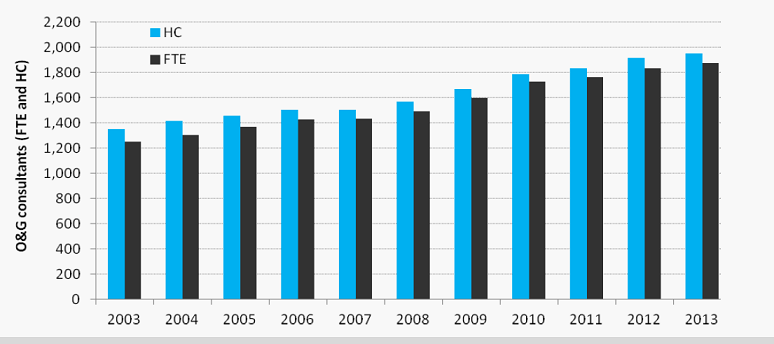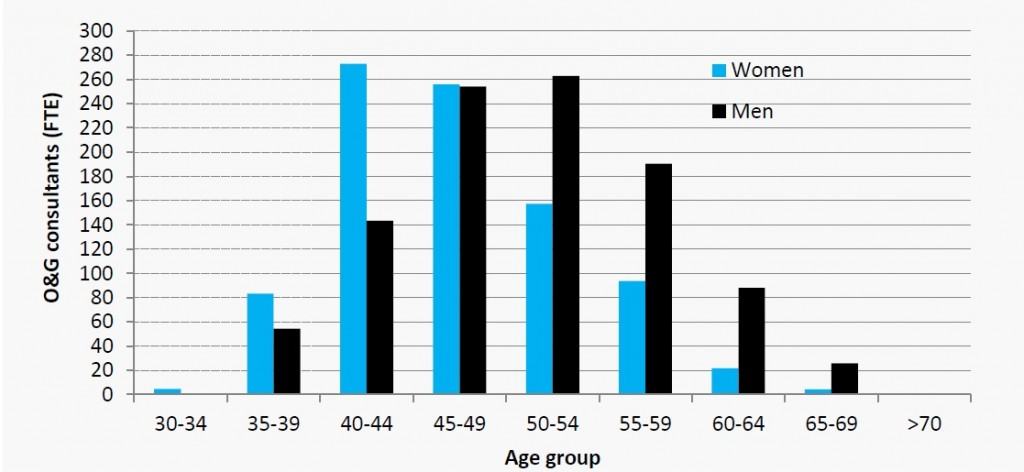Rig Locums are producing workforce updates on various specialist medical areas, providing informative insight into the current workforce and projected future workforce demands in the UK. The first instalment will focus on the Obstetrics and Gynaecology workforce based on the CFWI report produced in January 2015.
In 2003 there were 1,253 FTE O&G consultants and this rose significantly to 1,872 FTE consultants in 2014 that is an increase of 53% (HSCIC, 2014). O&G consultants account for approximately 28% of the NHS consultant workforce, and 4.8% of the total medical consultant workforce including general practitioners (GPs). The latest census results suggests 57% of consultants practise both obstetrics and gynaecology, with 19% practicing only gynaecology and 11% practicing only obstetrics.

Age and Gender Profile
The number of women in the O&G workforce has increased from around 200 in 1998 to more than 893 in 2013 – an increase of 347 per cent. As of 2013, 47 per cent of O&G consultants are women. Over the same period that saw the number of women in the specialty grow, figures indicate an increased participation rate (i.e. the extent to which consultants work full time or part time with 1.0 being full time) for women from 0.89 in 1998 to 0.95 in 2013. The younger O&G consultant workforce is predominantly women, as opposed to the O&G workforce aged 50 and older.
The number of men in the workforce increased from around 800 in 1998 to 1,021 in 2013 – a growth of 28 per cent. Overall, the participation rate has grown over this time (with the exception of 1999 to 2011 when it fell to 0.91).
There has been an overall increase in the average individual participation rate over the last 15 years from 0.89 in 1988 to 0.95 in 2013 for women and from 0.94 in 1988 to 0.95 in 2013 for men. The proportion of women in the O&G workforce is likely to continue to rise. Of all doctors in specialty training in O&G, 81 per cent are women, based on the 2013 intake gender split and existing specialty trainees.

Education and academic workforce issues
Surveys of the heads of school of O&G and the trainees’ committee representatives in England have shown a significant number of ‘gaps’ in current registrar rotas (RCOG, 2014a). These are due to a combination of various factors including maternity leave, less than full-time working, out-of-programme activity, and retention issues in the early years of the training.
These rota gaps are creating pressures that impact trainees by increasing service pressures and result in a significant number undertaking locum appointments for service (LAS) posts (RCOG, 2014a).
Therefore they may be working hours in excess of the European Working Time Directive (EWTD). Locums for service and agency locums are also used (RCOG, 2014a). Combination of these factors may impact training opportunities. It is important to note that the issues described above refer to current educational training arrangements and a workforce situation that is likely to change in the future with growing O&G workforce supply and changing delivery models.
References
Royal College of Obstetricians and Gynaecologists (RCOG) (2014a) Attrition rates from O&G training. Survey results from the Heads of Schools in England. Email communication to the CfWI. [Accessed July 2014].
Health and Social Care Information Centre (HSCIC) (2014) NHS Hospital and Community Health Service (HCHS) Workforce Statistics in England, Medical and Dental staff – 2003-2013, as at 30 September. [online] Available at: <http://www.hscic.gov.uk/article/2021/Website-Search?productid=14384&q=medical+and+dental&sort=Relevance&size=10&page=1&area=both#top> [Accessed July 2014].
